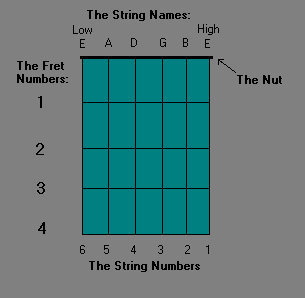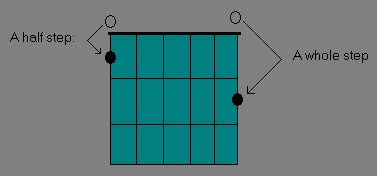The Open Position...
Before we can start our exploration of the major scale let me teach you how to read tableture diagrams for the guitar. (We already looked at a similar type of diagram in Lesson 1, but let's make sure we don't leave any rocks unturned so to speak.)
I will be using these diagrams throughout my lessons. I think these pictures illustrate where things are located on the guitar neck in a very straight-forward and succinct way. As you may already know, the guitar is a very visually oriented instrument and I find that these diagrams really help one to understand its layout quickly and easily.

As Figure 1 shows, the horizontal lines represent frets on the guitar. The only exception to this is the top-most horizontal line which represents the nut. The nut is where the open strings rest on the guitar neck -- the end of the guitar close to where the tuners are located.
I have drawn the nut with a thicker line to show this distinction from a fret, but I won't always make this distinction in my drawings. The vertical lines represent the strings of the guitar. The low E string is called the sixth string while the high E string is called the first string.
It's important to get this notation and termonology straight as I will be using it to locate specific areas on the guitar from time to time. This diagram is a drawing of the first four frets on the guitar and this area is sometimes called first position or the open position.
The C Major Scale...
Let's continue our study of music theory by examining the notes in the C major scale. This exploration will provide you with the foundation needed to approach more advanced concepts.
The C major scale contains only natural notes, that is, there are no sharps or flats in this scale. The first note of any scale is called the root and in this case the root note is C. All of the other notes in this scale have a special and unique relationship to the root.
As you will discover, music theory is really a language that describes the relationships or distances between notes. Once you understand this "language of comparisons or distances" you will have most of the vocabulary needed to understand music theory.
So here we go... the notes in the C major scale are: C, D, E, F, G, A, B, C. As you can see, this scale contains eight notes. It starts and ends with a root note. Another interesting observation is that there are only seven notes with unique names. The root is repeated in this sequence. This second root is one octave (or 12 half steps) higher than the first root in the sequence.
Now let's examine the relationship between each adjacent note of the scale which will lead us to a more formal definition of how a major scale is constructed. As you will soon discover the major scale has only two kinds of distances between adjacent notes - whole steps or half steps.
A Slight Review: On the guitar a half step is one fret's distance between two different notes on the same string. For instance, play any note on the guitar. Now to play a half step higher from the note you just played, move your finger up one fret on the same string. To play a whole step higher, move your finger 2 frets higher from the original or starting note you played. Here is a picture to illustrate what I mean.

In Figure 2, the half step lies between the open low E string and the first fret of the low E string. The whole step lies between the open high E string and the second fret of the high E string.
Direction Follows Pitch...
When I say "up on the guitar," I mean moving from a lower to a higher fret position on the guitar neck. When I say "down on the guitar," I mean moving from a higher to a lower fret position. From my experience this concept of "direction following pitch" sometimes causes some beginner guitar players confusion. Consult the following picture:

Essentially, there are two ways to move around on a guitar: horizontally, which is playing up and down on one string, and vertically, which is playing in a "fixed" position on all 6 strings of the guitar. (Playing vertically is usually referred to as position playing by most.) Of course, great players interweave these two kinds of playing seamlessly.
The Major Scale Formula...
Alas, here is a formal definition for the major scale. A major scale consists of a series of 8 notes with half steps between the 3rd and 4th scale degrees as well as half steps between the 7th and 8th scale degrees. All other intervals between adjacent notes of the scale are whole steps.
Figure 3 illustrates this concept:

Go to the next lesson, Lesson 3, or go back to the main menu.